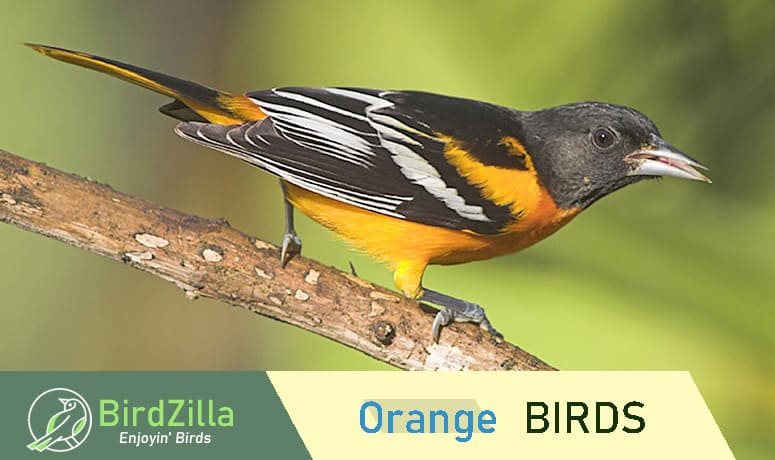
Psst! Have you spotted a flamboyant orange birds in your backyard? Don’t fret, my feather-loving friend! Check out these eye-catching bird pictures, generously shared by our readers, to give you a leg up in identifying that colorful creature. Who knows, you might just discover a newfound appreciation for the avian world!
We’ve compiled a list of the most common orange birds! Some of these birds may be primarily orange, while others may only have sections of orange.
These birds are found in a wide variety of bird groups, and they can be found in many portions of North America.
Some orange birds (most of them are male! Females of the same species may be brown, green, yellow, etc.) are found in dry open areas, while others favor mixed forests. Orange is a color that can be found in nature in various shades. It can be bold and bright to rufous or rusty.
So, let’s dive in…
On this page
- #1 American Robin
- #2 Carolina Wren
- #3 Rufous Hummingbird
- #4 Baltimore Oriole
- #5 Orchard Oriole
- #6 American Woodcock
- #7 Red-Breasted Nuthatch
- #8 American Redstart
- #9 Black-headed Grosbeak
- #10 Bullock’s Oriole
- #11 Allen’s Hummingbird
- #12 Varied Thrush
- #13 Blackburnian Warbler
- #14 American Avocet
- #15 Altamira Oriole
- #16 Eastern Towhee
- #17 Scarlet Tanager
- #18 Hooded Oriole
- #19 Spotted Towhee
- #20 Flame-colored Tanager
#1 American Robin
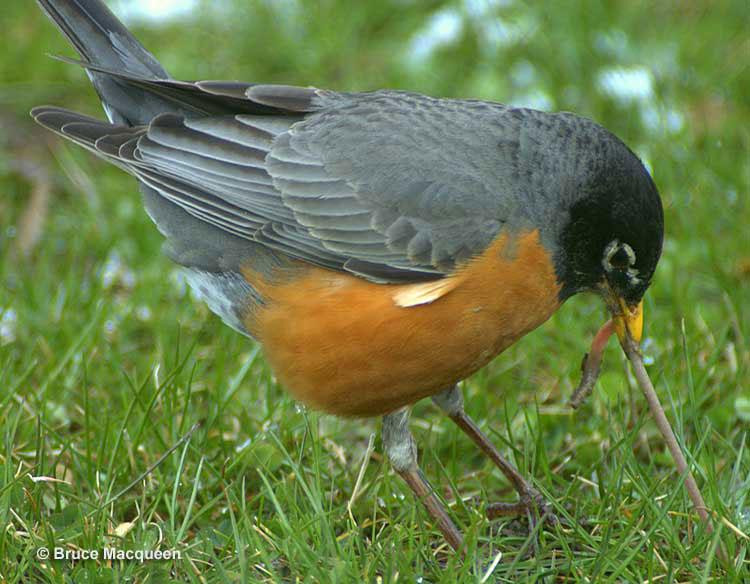
American Robins are relatively large songbirds with round orange and gray-brown bodies. They’re the largest thrush in North America. In flight, the lower belly and under tail can be seen, showing off the white patch on both parts.
See more: Birds that look like robins
In comparison to male American Robins, females are paler overall. This is because they contrast less with the gray on their back and lighter heads. This partially orange bird can be found year-round in the entirety of the United States.
Robins that breed in Alaska’s north slope to Canada leave in the fall for the United States. Some birds winter as far south as Mexico, the Gulf Coast, and the Southwestern portions of the United States.
#2 Carolina Wren
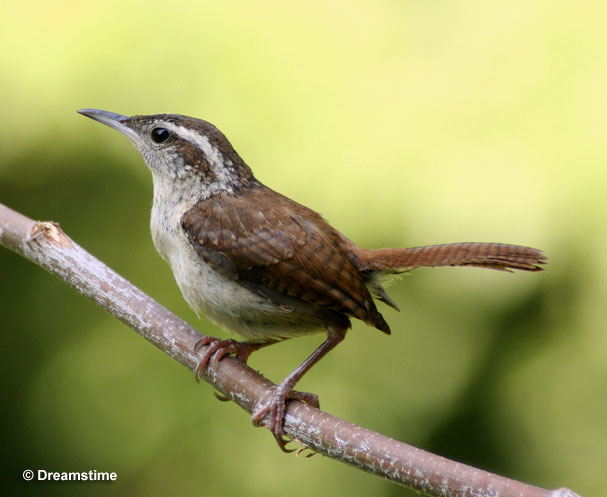
Carolina Wrens are chunky, small birds with long tails and round bodies. Their tails are distinct because they’re often cocked upright. This wren has a fairly large head and very little neck. Another distinctive feature of this bird is the slender, long, and downcurved bill. They’re slightly smaller than a sparrow and a little bit larger than a House Wren.
Male and female Carolina Wrens look very similar. They’re both unpatterned, warm buffy-orange below and bright reddish-brown above.
Additionally, they have white chins, white throats, dark bills, and long white eyebrow stripes. These birds can be found in the eastern half of the U.S., northeast Mexico, and southern Canada.
#3 Rufous Hummingbird
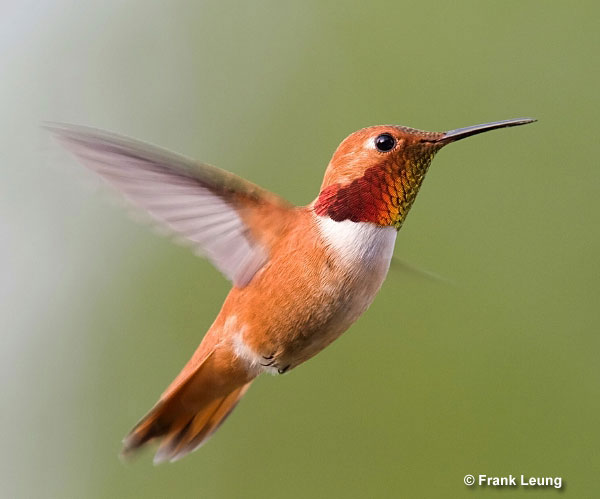
Rufous Hummingbirds are relatively small hummingbirds with brownish-orange plumage. They’re bout the same size as Ruby-throated Hummingbirds.
In direct sunlight, the orange on male Rufous Hummingbirds is striking.
They have bright orange bellies and backs and bright iridescent-red throats. Female Rufous Hummingbirds have rufous-washed flanks, green upper parts, rufous patches in their green tails, and a small area of orange on the throat.
Related: Bird Quotes to Make Your Day Brighter
These birds can be found in the western portions of the United States, Canada, and Mexico. They’re long-distance migrants. These orange birds will travel almost 4,000 miles from their breeding grounds in northwest Canada and Alaska to their wintering grounds in Mexico.
#4 Baltimore Oriole
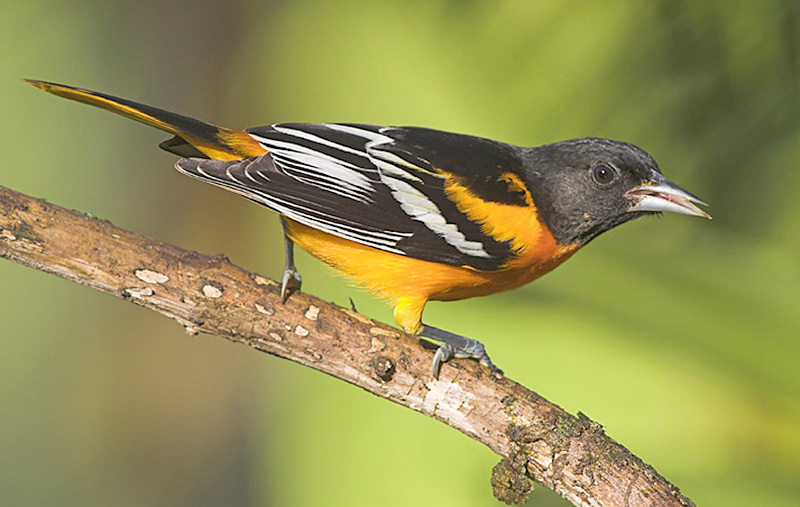
The Baltimore Oriole is a sturdy, medium-sized songbird with primarily black and bright orange. They have one white bar on their wings and black heads. Young Baltimore Orioles have two solid white wing bars, grayish heads, grayish backs, as well as yellow-orange on the breast.
For some of the year, Baltimore Orioles can be found in the eastern portions of the U.S. and as far west as the state of Montana.
Populations of Baltimore Orioles that migrate head south in the early fall and late summer to Central America, South America, and the Southeast U.S. until April. They prefer to inhabit open deciduous woodlands.
#5 Orchard Oriole
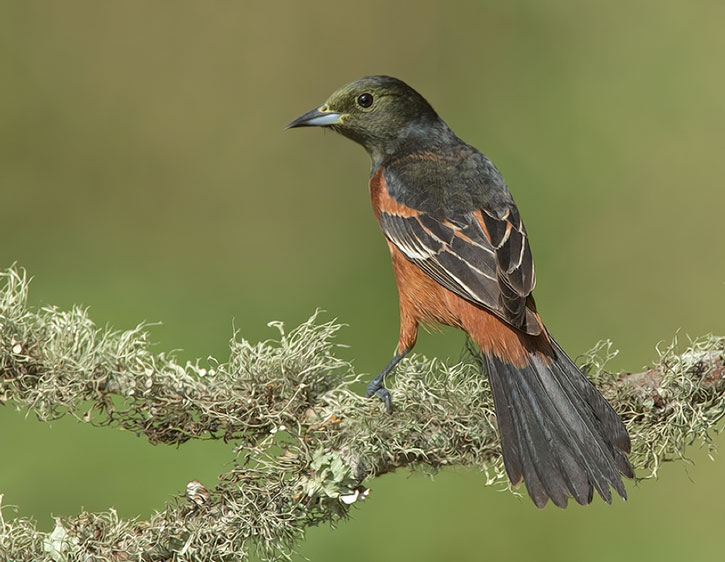
The Orchard Oriole is a slender songbird. They have rounded heads, straight, pointed bills, and medium-length tails.
Males are rusty orange below and black above. Additionally, they have a reddish-chestnut patch on the wing and a black throat and head. Female Orchard Orioles look very different from breeding male Orchard Orioles. They have two white wing bars and greenish yellow overall.
Related: Birds that look like orioles
Look for these birds along river edges in open woodlands, as well as lakeshores, marsh edges, farms, and open shrublands. In open habitats, they nest in scattered trees.
Orchard Orioles winter in tropical forest edges, thickets, plantations, lightly wooded areas, and shady pastures. Orchard Orioles are long-distance migrants. They fly from the eastern portions of North America to wintering grounds in northern South America and Mexico.
#6 American Woodcock
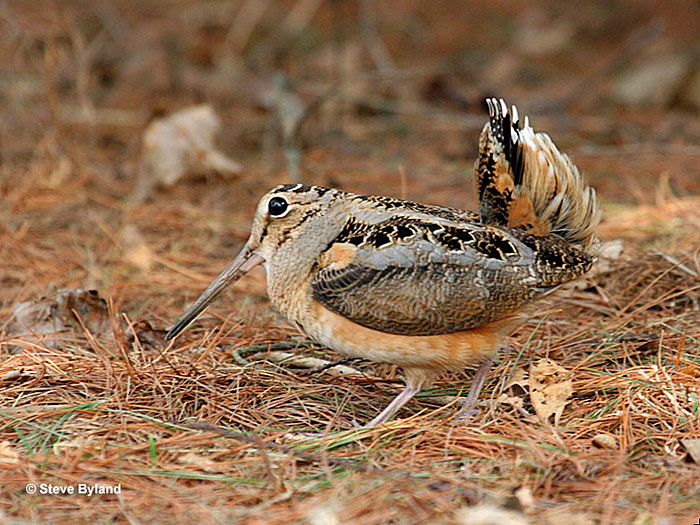
The American Woodcock is a short-legged, plump shorebird. It has a straight, very long bill, short tail, short neck, and large head.
Their wings are rounded and wide in comparison to the majority of other shorebirds. They’re a little bit smaller than a Rock Pigeon, plumper, and bigger than a Killdeer.
American Woodcocks are well camouflaged with their gray-brown tones.
The crown is blackish, and the face is buffy. They are light gray across their backs and necks, have brown wings, and dark-and-light patterned shoulders. The underparts are almost orange.
These birds are short-distance migrants and residents. They can be found in the eastern half of the U.S. and Canada. Most birds migrate south for winter while staying in North America. However, some southern populations will remain in the same place for the whole year.
#7 Red-Breasted Nuthatch
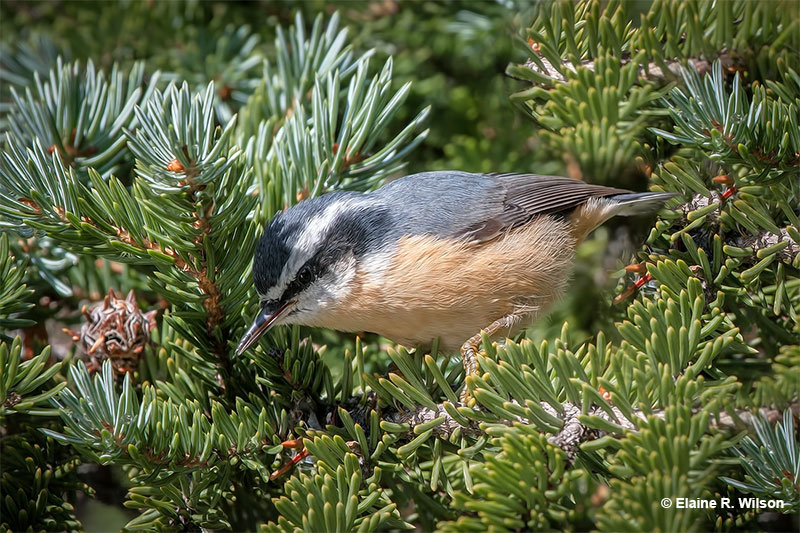
© Elaine R. Wilson
Red-breasted Nuthatches are small birds with orange undersides. They have short tails, almost no neck, and broad short wings. To make identification easier, they are noticeably smaller than the White-breasted Nuthatch.
These birds are blue-gray overall and have strongly patterned heads. Additionally, they have a black stripe through the eye bordered with white on both sides and light orange underparts. Females look the same but are paler overall.
This bird can be found in the majority of the United States and Canada. They’re short-distance migrants and residents. The birds in the northern portion of their range migrate south every year, but populations farther south sometimes don’t migrate at all.
#8 American Redstart
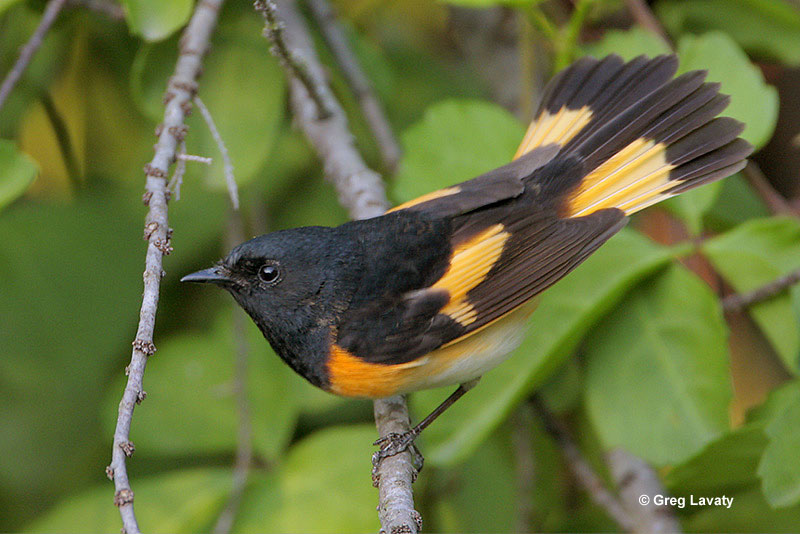
The American Redstart is a medium-sized warbler with a flat, fairly wide bill, long, expressive tail, and slim bellies. Males look completely different from female American Redstarts.
Males are primarily black and have bright orange patches on their sides, tail, and wings. Their bellies are white. Immature males and females have yellow, whereas males have orange. Additionally, they have gray underparts, gray heads, olive backs, olive wings, and dark-gray tails.
American Redstarts can be found in the majority of the U.S., Canada, Mexico, the Caribbean, Central America, and South America. These birds are long-distance migrants. Those who breed in eastern North America will travel to Florida, northern South America, and the Greater Antilles.
Those who breed in western and central North America migrate to Central America, South America, and Mexico.
#9 Black-headed Grosbeak
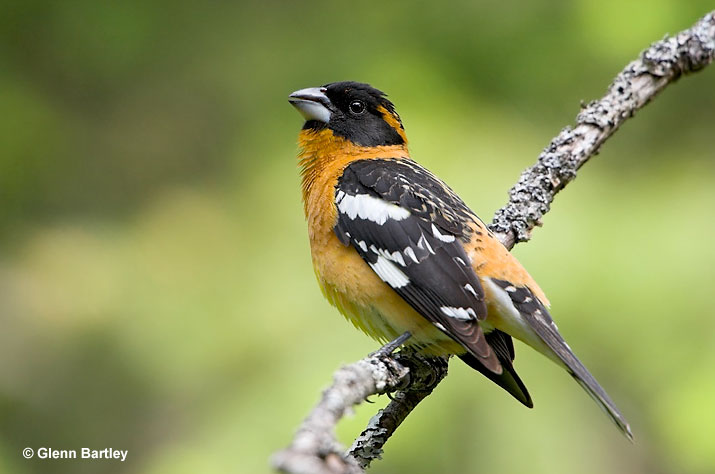
The Black-headed Grosbeak is a hefty songbird with large bills. They are easy to tell apart by their black and orange plumage, which has some white spots on wings and tail. Females look more brown, but still have warm orange tones on the chest.
These birds can be found in the western half of the United States, southern Canada, and Mexico. They’re residents in parts of Mexico, but primarily, they’re medium to long-distance migrants.
#10 Bullock’s Oriole
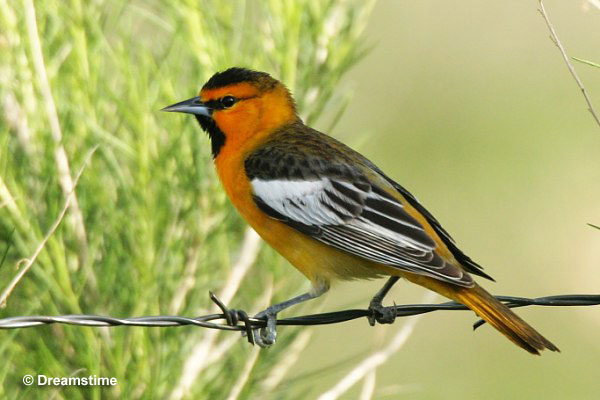
The Bullock’s Oriole is a medium-sized birds with some orange tones on their chests and bellies, as well as around their necks and on their tails.
Males have large white wing patches, black back, and are overall bright orange. They have black throats and orange faces with a black line through the eye. Females have grayish backs, white-edged wing coverts, and are yellowish-orange on the tail and head.
These birds can be found in the western portions of the United States and are medium-distance migrants. Most Bullock’s Orioles winter in the western parts of Mexico, but a few birds are permanent residents of coastal southern California.
#11 Allen’s Hummingbird
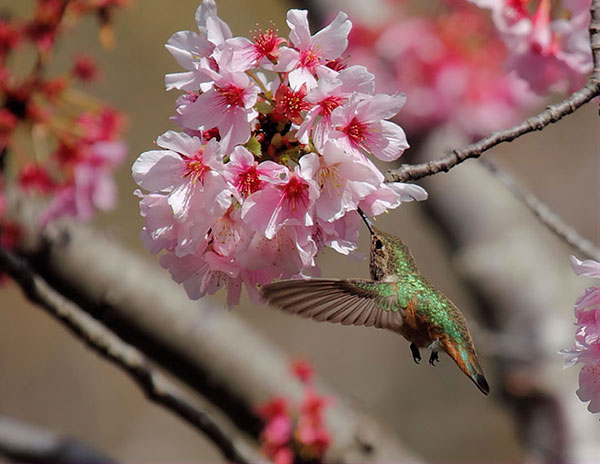
Allen’s Hummingbird
The Allen’s Hummingbird is a stocky and compact hummingbird. Their bills are long and about the same length as their head. Their tails are long as well and extend past their wings when perched. This hummingbird species is slightly smaller than an Anna’s Hummingbird and larger than a Calliope Hummingbird.
Adult male Allen’s Hummingbirds have an eye patch, coppery tail, and belly that contrasts with their deep orange forget and bronze-green back. Immature males and females have paler coppery sides and are bronze-green above. They both have some bronze spotting on their throats.
These birds are found on the Pacific coast, southern California, Arizona, and Mexico. They’re medium-distance migrants and residents. Individuals that breed along the coast fly to Mexico for the winter. However, birds that breed around Los Angeles and the Channel Islands are usually year-round residents.
#12 Varied Thrush
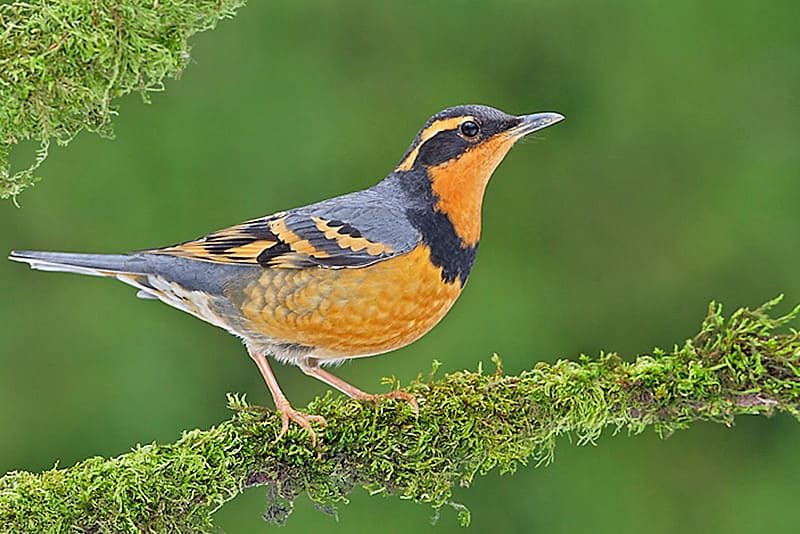
Varied Thrush (Ixoreus naevius) perched on a branch in Victoria, BC, Canada.
The Varied Thrush is a stocky songbird with rounded, large heads, long legs, and straight bills. They’re commonly seen in a tree or on the ground.
Male Varied Thrushes are rich burnt-orange below, dark blue-gray above, have a sooty-black breastband and an orange line over the eye, and an orange throat. The wings have orange bars, orange edging to the flight feathers, and are blackish overall. Female Varied Thrushes have similar patterns but are paler overall.
These birds are short-distance migrants. Some birds stay in one place all year, while inland birds migrate south for the winter.
#13 Blackburnian Warbler
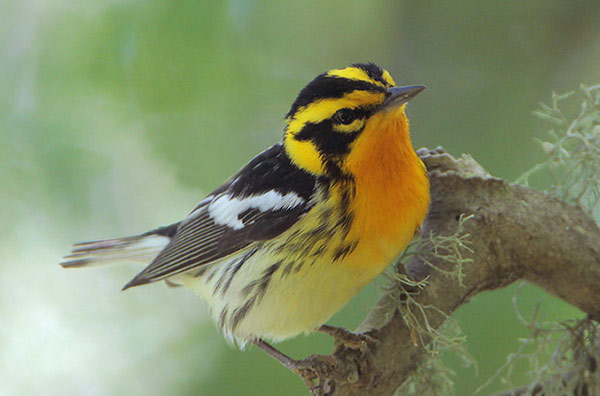
The Blackburnian Warbler is a medium-sized warbler with medium-length tails, short, pointed bills, and slim bodies.
Male Blackburnian Warblers have bright orange on their throats and faces. Young birds and females show a hint of this coloration. All birds have a unique triangular facial pattern of gray or black.
These birds are medium-distance migrants. They can be found in the eastern portions of the United States, Southern Canada, the Caribbean, Eastern Mexico, Central America, and South America.
#14 American Avocet
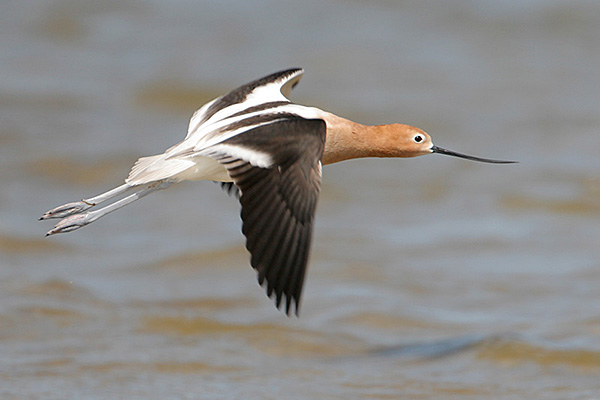
Photograph © Greg Lavaty
The American Avocet is a large yet slender shorebird. They have rounded heads, long, upturned bills, long necks, and long legs.
Males have rusty orange necks and heads that turn gray or white once the breeding season is over. A black patch can be seen on the back, and their legs are bluish-gray.
These birds are medium-distance migrants. They can be found along the southwestern coast, southeastern coast, the central western states of the U.S., southern Canada, the Caribbean, and Mexico.
#15 Altamira Oriole
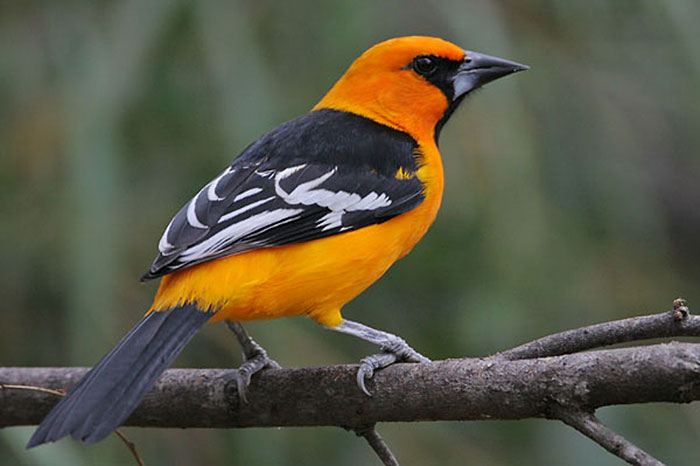
The Altamira Oriole is a large songbird with a stocky body, long tail, and relatively large head. Their bills are thick at the base but sharply pointed and long towards the tip.
Adults are black and orange, with the brightest orange on the face. They have black on the chin, back, tail, wings, and in front of the eye. Additionally, they have orange shoulders and white wing bars.
Young birds don’t have the orange shoulders, olive-brown above, and are yellowish-orange overall.
These birds do not migrate and are year-round residents of the southern tip of Texas, Mexico, and Central America.
#16 Eastern Towhee
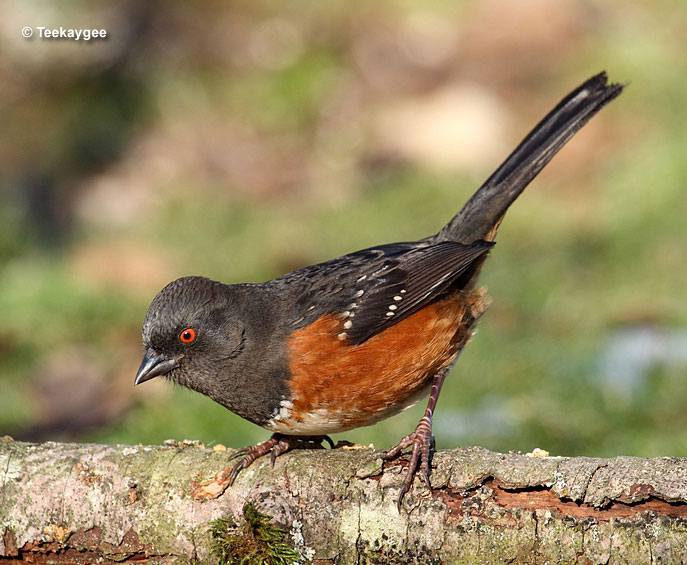
Eastern Towhee is a sparrow with orange coloring. Their backs and wings are black, but their sides are bright, rusty color. Females are much browner in color. They have strong black beaks and black heads.
Related: Birds with orange chests
In the United States, Eastern Towhees are found on the eastern side, extending to some parts of Canada.
Eastern Towhees sometimes find their way to backyard feeders, they like sunflower seeds, peanuts, and millet.
#17 Scarlet Tanager
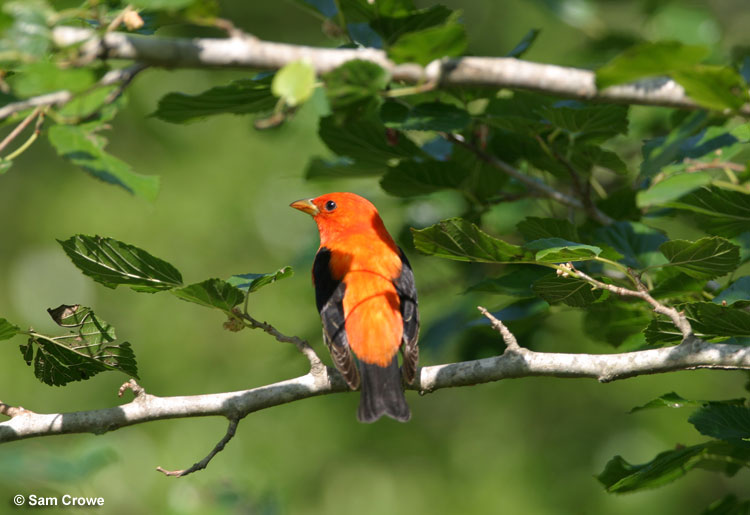
Scarlet Tanagers are songbirds with bright red or orange plumage and black wings. Females are more yellow in color and look similar to other female tanagers.
These medium-sized birds are common in the Eastern United States and migrate to northern parts of South America.
They are often spotted around forests and even in boreal forests in Canada.
Scarlet tanagers feed mainly on insects, such as snails, ants, spiders, grasshoppers, plant lice, and termites. They also like fruit and occasionally some vegetation.
#18 Hooded Oriole
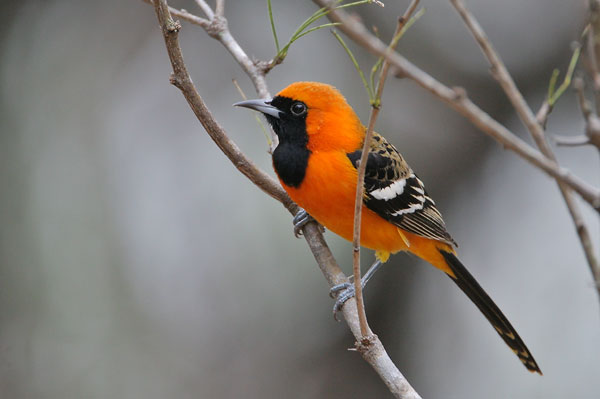
Photographs © Greg Lavaty.
Hooded Orioles are bright orange orioles with black wings and black spots on their faces. Depending on location, they are sometimes more yellow.
Females are pale yellow in color and have brown wings and tails.
Hooded Orioles prefer open woodlands. They like to stay hidden, but you might still see them in your backyard.
Their diet consists of insects like spiders, ants, caterpillars, beetles, and grasshoppers, and they also enjoy fruit and nectar.
#19 Spotted Towhee
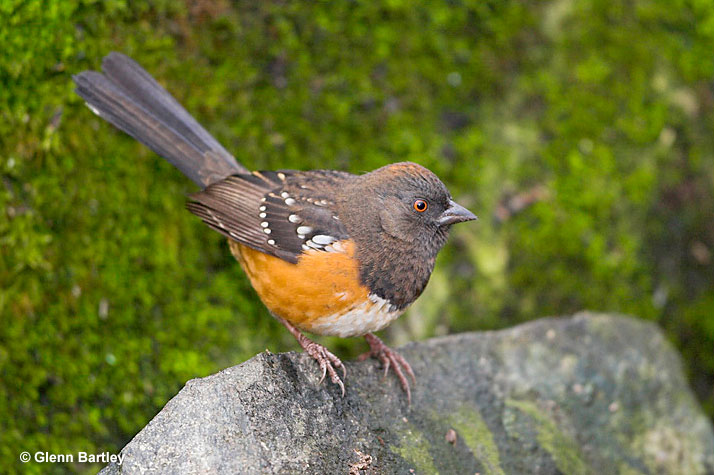
Spotted Towhee is a large New World sparrow with orange and black plumage. Their backs and wings are black, but sides are rusty orange. This orange bird species has a white belly extending down from their chests.
Males and females look alike, but females are usually slightly duller in color.
Spotted Towhees often prefer shrubs or thickets in the western side of North America, including the western United States. They sometimes visit bird feeders.
#20 Flame-colored Tanager
Flame-colored Tanagers are orange-colored managers. Males are bright orange in color, with dark wings, while females have much more laid-back plumage.
Female Flame-colored Tanagers are yellow, with brownish wings. Both males and females have similar pattern on their wings.
These birds are commonly seen in Central America, but some make their way to southern parts of the United States. Flame-colored Tanagers can sometimes be spotted in Arizona or Texas.
Which one is your favourite? Or did we miss something? Let us know in the comments below


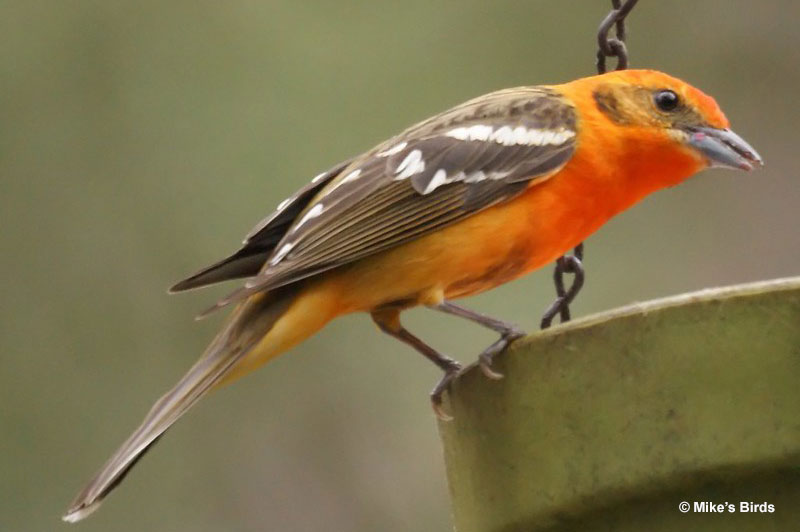
Kathie Burns Jung
Thursday 21st of March 2024
Thank you for your knowledge about bird identification! The bird I saw today while out feeding the birds, was an Altamira Oriole. I've never seen one of those before and it was Beautiful!!! I feed the wild birds every morning with a mix of wild bird seed and dried blue berries, dry meal worms and fresh orange slices. I give them fresh water, and bird baths all over our ranch.
Patrick O'Donnell
Saturday 23rd of March 2024
@Kathie- What a great sighting! Thank you for sharing it with us.